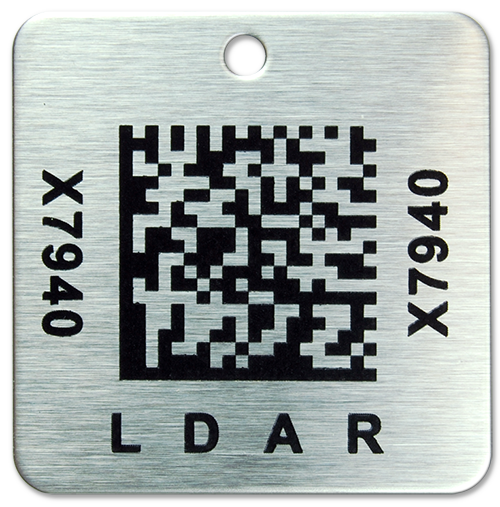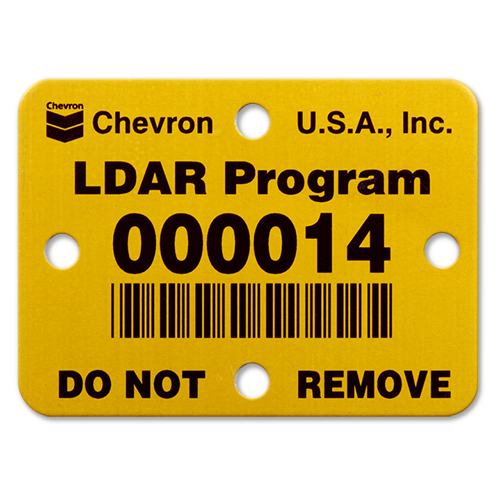Our Products
Complete customization is available for every item we produce. Any size, shape, color, or design and any barcode symbology. The representations you find here are examples but there are no limitations.
- Free Design Proofs.
- Numerous material options.
- Fastest Production and Delivery.
- Value pricing for quantities large and small.
- Complete Satisfaction Guaranteed.
- Call for no-obligation Design Proof.
Emissions Monitoring Tags
Barcoded LDAR tags for checkpoint identification
LDAR tags for checkpoint identification for EPA Fugitive Emissions compliance programs. LDAR valve tags, checkpoint tags, steam trap, joint and connection identification for every LDAR monitoring location. Custom designed to meet your needs LDAR labels can carry whatever data you require. Anodized aluminum valve labels, stainless steel LDAR tags. Barcoded with your straight sequence or your special data schema as well as any special valve identification information you may require. Subsurface photo imaged aluminum, etched steel, and laser marked steel with or without Teflon coating. Durable and lasting tagging for oil or gas field or refinery or processing and transmission.
TESTIMONIALS
The label looks amazing. Thank you for taking the time to meet our requirements and provide the sample labels quickly. My manager was impressed with how quickly you provided a sample via email. We look forward to working with you to meet our asset tag needs.
When looking for a new vendor for labels, I reached to to Express and they were very knowledgeable and helpful. After waiting for days from a large company, these guys had fast turnarounds for quotes, and the pricing was better than the mighty conglomerate that had me waiting.
Evan was very helpful and always available when I had a question. Great service you guys!
I have to say you are all so easy to deal with at Express, it really is a pleasure doing business with you!!!
I just wanted to let you know that the labels arrived in a timely manner and they looked great! I just wanted to express my thanks to you for the outstanding job that you did in making things happen in such a short window.
Requested a quote for product information and pricing and received a response the same day. Not too often that same day responses are provided from vendors, especially for the type of request that was put through. Good stuff and will keep in the file for a Go-To company.
We have been buying stainless steel barcode plates from Express for over 10 years. Excellent quality and delivery!
Thank you so much for processing our ID plates so quickly and getting them shipped earlier than projected! I am sincerely grateful for your efforts with this and providing us the items in a timely manner. Looking forward to doing business again in the near future.
I just want to say how nice they [the tags] look, how well they were packaged, how appreciative I am that you got them to us in time and communicated with me during this order. Thank you so much!
We will let you know if we ever need anything else. Ya’ll have been great!
I am impressed! Thanks for the fast service.
We got the labels and everyone here really likes the quality and appearance of them. I’m working on another order for you of the UID labels and will have that data out next week. Thanks!
We are extremely pleased with our order. You blew us away with your quick, reliable service and will be our only source for UIDs in the future.
We have used Express a number of times and the quality and service CANNOT be beat! Everyone works hard to ensure your order is correct and on time (if not early)! I cannot say enough good things about them!
Trusted By The Best















READY TO TALK?
We are ready to assist you. Contact us by phone or email or send a request form.
We will provide pricing promptly, or answer any questions you may have. We look forward to hearing
from you. CustomerService@ExpressCorp.com 800 382‐2323 1+858 549‐9828

